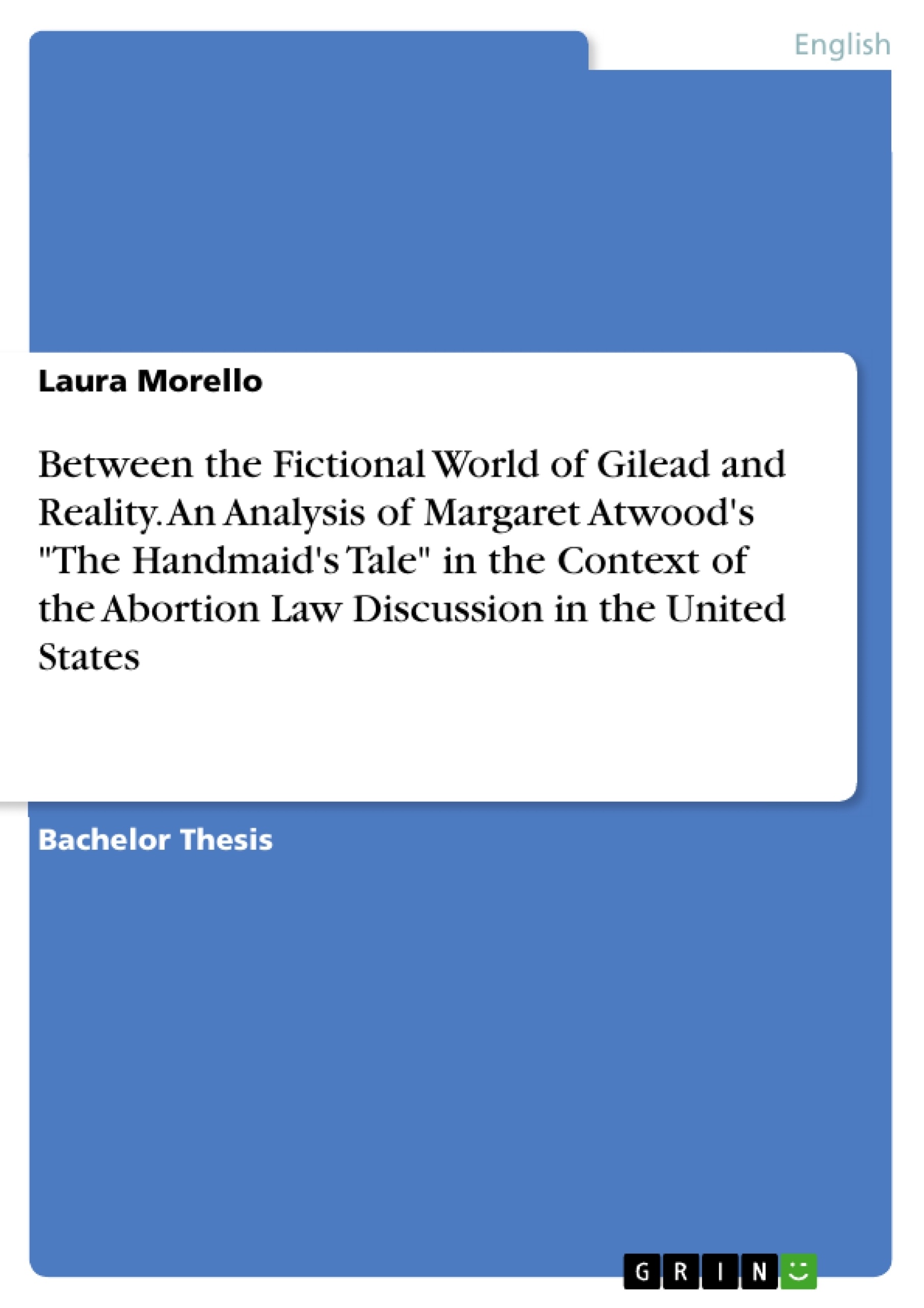This paper thoroughly examines the profound analogies between At-wood's dystopian universe and the ongoing debates over abortion rights in the U.S. It illustrates how the fictional world of Gilead functions as a reflection of real social anxieties and political controversies. To support this thesis, various sources and literary works are drawn upon to explore key features that will substantiate the argument throughout the paper. Since abortion laws in the United States are a highly controversial and dynamic issue, constantly subject to change, current developments must always be taken into account. By the time this work is read, new legal or societal changes may have already occurred.
On June 24, 2022, news shook the United States (U.S): The Supreme Court had overturned the historic Roe v. Wade ruling. In an instant, the decades-long guarantee of the right to abortion was over. This led to massive protests, especially among women, who used the slogan "My body, my choice" as a powerful symbol of women's self-determination and bodily autonomy.
Abortion, the medical termination of an unwanted pregnancy, is not only a legal issue but also deeply rooted in the feminist movement. Feminism, which advocates for "[...] social, economic, and political equality of the sexes", sees control over one's own body as a central human right. The overturning of the ruling seemed to call into question many of these hard-won women’s rights and fueled the debate about gender equality as well as the role of women in American society.
The withdrawal of this freedom and control over one's own body by the state is contrasted in Margaret Atwood's dys-topian society Gilead in her novel The Handmaid's Tale (1985). "The story follows Offred, a handmaid who is forced to bear children for her commander in a society where women are stripped of their rights and treated as property". Gilead is a world in which women are stripped of their rights and freedom and their bodies are viewed as state property. They are not only classified according to their social status and usefulness to society but also subjected to an extreme control over their reproductive functions. The Handmaids act as "breeding machines" for the ruling elite to combat the low birth rate. Their bodies and fertility are rigorously controlled and instrumentalized, taking incapacitation and objectification to a terrifying extreme.
Inhaltsverzeichnis (Table of Contents)
- 1. Introduction
- 2. The Fictional World Gilead
- 2.1 Characteristics of Gilead as a Dystopian Society
- 2.2 Women’s Rights
- 2.2.1 Marthas
- 2.2.2 Wives
- 2.2.3 Handmaids
- 2.2.4 Aunts
- 2.2.5 Other Female Roles
- 2.3 Role of Religious Ideologies and Authoritarian Structures
- 3. Analysis of The Handmaid’s Tale
- 3.1 Main Themes
- 3.2 Gilead and Feminist Battles
- 3.2.1 The Second Wave of Feminism
- 3.2.2 The Dystopia as a Reflection
- 4. Discussion of the Abortion Law in the United States
- 4.1 Current Situation and Developments
- 4.2 Controversies
- 5. Parallels between The Handmaid’s Tale and Today’s Abortion Law in the United States
Zielsetzung und Themenschwerpunkte (Objectives and Key Themes)
This paper examines the profound analogies between Margaret Atwood's dystopian novel, The Handmaid's Tale, and the ongoing debates surrounding abortion rights in the United States. It aims to illustrate how Gilead serves as a reflection of real social anxieties and political controversies surrounding women's reproductive rights and bodily autonomy.
- Reproductive freedom and control
- Bodily autonomy
- Religious fanaticism and its misuse for oppression
- Rigid gender roles and their consequences
- Resistance and adaptation in the face of oppression
Zusammenfassung der Kapitel (Chapter Summaries)
Chapter 1: Introduction provides background on the overturning of Roe v. Wade and introduces the central argument: Atwood's Gilead mirrors current anxieties about abortion access in the US.
Chapter 2: The Fictional World Gilead details the dystopian society of Gilead, outlining its characteristics, the various roles and rights (or lack thereof) for women, and the intertwining of religious dogma and authoritarian control.
Chapter 3: Analysis of The Handmaid’s Tale delves into the novel's key themes, connecting them to the second-wave feminist movement and the societal climate in which the novel was written.
Chapter 4: Discussion of the Abortion Law in the United States presents an overview of the current situation regarding abortion laws in the US, highlighting recent legal developments and controversies.
Chapter 5: Parallels between The Handmaid’s Tale and Today’s Abortion Law in the United States directly compares the fictional world of Gilead with the contemporary situation in the US, focusing on the impact of restrictive abortion laws on women's reproductive rights.
Schlüsselwörter (Keywords)
The Handmaid’s Tale, Gilead, abortion rights, reproductive freedom, bodily autonomy, feminism, second-wave feminism, religious extremism, patriarchy, dystopian literature, United States, Roe v. Wade, Dobbs v. Jackson Women’s Health Organization, resistance.
- Quote paper
- Laura Morello (Author), 2024, Between the Fictional World of Gilead and Reality. An Analysis of Margaret Atwood's "The Handmaid's Tale" in the Context of the Abortion Law Discussion in the United States, Munich, GRIN Verlag, https://www.grin.com/document/1514706



